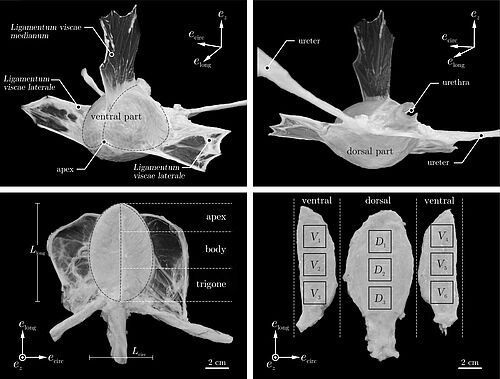
Basic Funding

The urinary bladder is the central organ of the urinary tract and has two main functions: the intermediate storage of urine and the controlled micturition. During such a cycle, enormous deformations occur and the load transfer mechanisms involved are not yet fully understood.
While experimental and numerical investigations on healthy organs generally serve the basic understanding, investigations on diseased organs are additionally of social, clinical, and economic interest. Thus, within the framework of this follow-up proposal, in addition to the completion of outstanding work, the developed bladder model will be extended and used to simulate the influence of bladder diverticula on bladder function.
Bladder diverticula are balloon-like growths on the bladder, which can lead to various complications (e.g. stone formation, drainage disorders, colic). First, two forms of artificial bladder diverticula (congenital and acquired diverticula) are applied to healthy bladders and then modelled.
In order to describe congenital diverticula, the contractility of the muscularis should be reduced locally by adding a cross-bridge inhibitor. Acquired diverticula, on the other hand, are provoked by the removal of the muscularis. When the bladder fills up or contracts, the increase in internal bladder pressure causes the bladder mucosa to protrude (through the muscular gaps), resulting in the formation of artificial diverticula.
To be able to depict the formation of diverticula by means of a numerical model, the existing model is being further extended accordingly. On the other hand, the mechanical properties of the bladder diverticula must be characterised experimentally, which is done both through experiments at tissue strip level and through experimental investigations at whole organ level.
Based on the experimentally determined three-dimensional deformation data and pressure curves during micturition, the bladder diverticulum model will be validated. This would provide the first three-dimensional bladder model that can describe and predict the complex interaction between bladder diverticula and bladder as well as the tissue stress in the marginal area of the diverticula, which are presumably partly responsible for the further development of the disease pattern.
In addition, a systematic investigation of various factors influencing bladder function and thus a deeper understanding of the clinical picture would be possible in the future.
